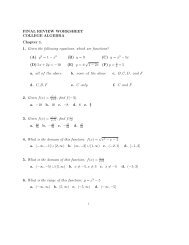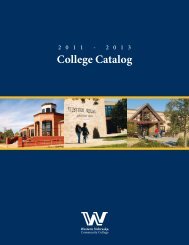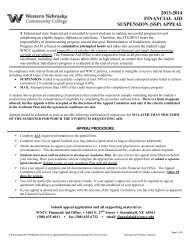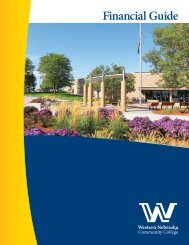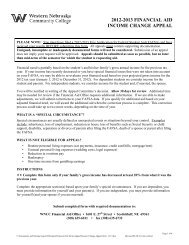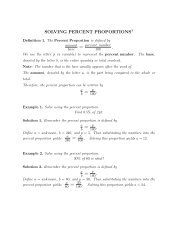WNCC 2010 Self-Study Report - Western Nebraska Community ...
WNCC 2010 Self-Study Report - Western Nebraska Community ...
WNCC 2010 Self-Study Report - Western Nebraska Community ...
Create successful ePaper yourself
Turn your PDF publications into a flip-book with our unique Google optimized e-Paper software.
Another example of the CAAP test results appears below:<br />
Table 7-34 Spring 2008 CAAP Results<br />
Test Area <strong>WNCC</strong> National<br />
Writing Skills 62.1 62.1<br />
Mathematics 56.7 56.2<br />
Reading 60.3 60.5<br />
Critical Thinking 59.7 60.9<br />
(RR 68)<br />
The results of the CAAP exam are distributed by the Institutional Researcher to members of the<br />
institution at all sites via an Outlook communication. Individual division personnel or academic<br />
leaders are charged with the responsibility of understanding the performance report to interpret<br />
possible implications for instruction. For instance, the institution forwards critical thinking as one of<br />
its primary goals within the general education goals, although in the 2008 results the measured<br />
competency (as indicated by this particular instrument at this time of administration) has slipped.<br />
Courses which feature critical-thinking or problem-solving, or even aspects of critical thinking,<br />
should be examined by faculty members to determine whether a change in curriculum, instructional<br />
delivery, supplementary materials, or content sequencing and emphasis seems necessary.<br />
CCSSE Survey<br />
In 2007, <strong>WNCC</strong> participated in the <strong>Community</strong> College Survey of Student Engagement (RR 69).<br />
At the same time, the faculty members were asked to take the <strong>Community</strong> College Faculty<br />
Survey of Student Engagement (CCFSSE). The CCSSE instrument utilizes five benchmarks,<br />
which are 1) Active and collaborative learning; 2) Student effort; 3) Academic challenge; 4)<br />
Student-faculty interaction; and 5) Support for learners, as shown below:<br />
100<br />
Figure 7-35 <strong>Community</strong> College Survey of<br />
Student Engagement<br />
80<br />
60<br />
40<br />
47.4<br />
52.8 51.2 51.1<br />
53.7<br />
20<br />
0<br />
Active &<br />
Collaborative<br />
Learning<br />
Student Effort<br />
Academic<br />
Challenge<br />
Student-Faculty<br />
Interaction<br />
Support for<br />
Learners<br />
<strong>Western</strong> <strong>Nebraska</strong> <strong>Community</strong> College Page 103



